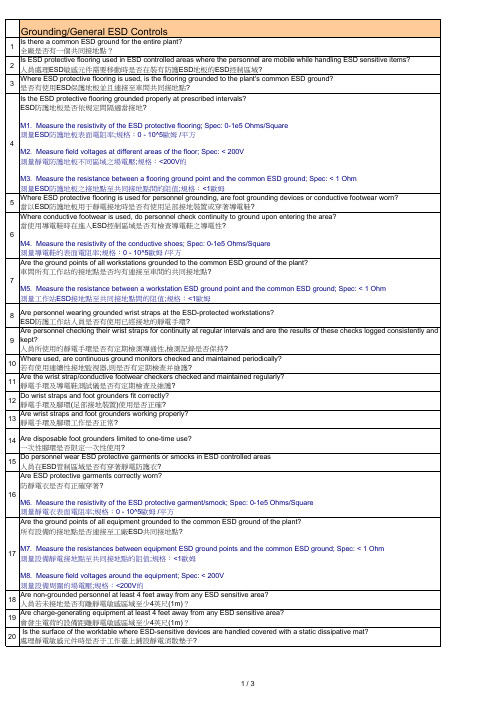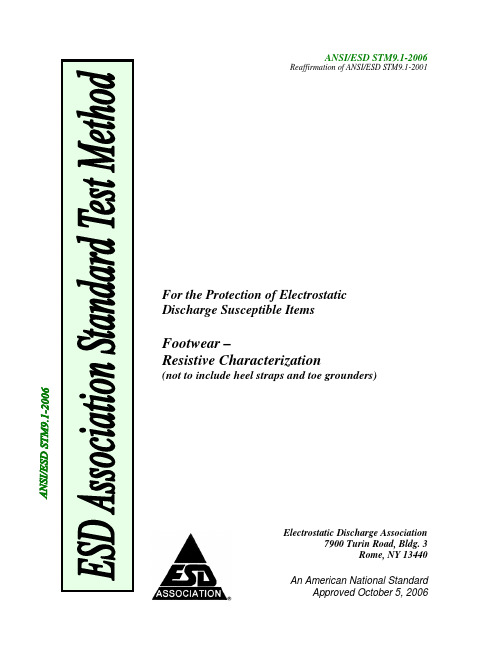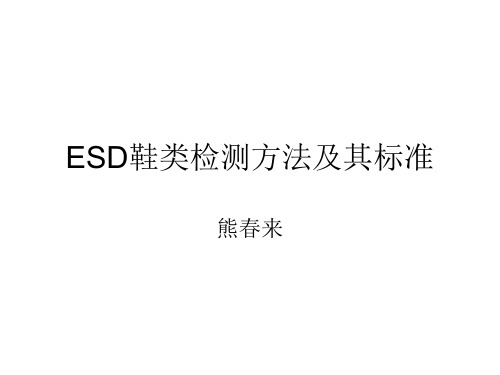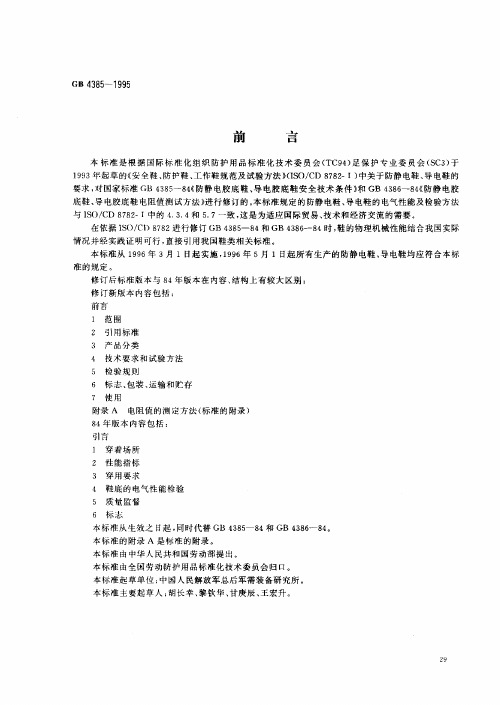ESD specification conductive footwear
- 格式:pdf
- 大小:242.77 KB
- 文档页数:3

版本变更记录版本变更内容描述批准人批准日期A 初版发行(恒信静电中心培训专用)目录1目的2适用范围3名词解释4功能权责5生产流程6管理要求6.1基本原理6.2修正6.3静电敏感件6.4ESD培训6.5产品认可6.6符合性验证6.7接地6.8人员接地6.9EPA6.9.1区域界定6.9.2人员管控6.9.3绝缘体管控6.9.4孤立导体管控6.10包装6.11标记7持续改进8相关程序文件及记录表单9参考文件1.目的公司按照ANSI/ESDS20.20和IEC61340-5-1标准实施静电防护管理,其目的在于:1)减少静电对产品的损害,提高产品品质,提高客户满意度。
2)明确静电防护措施和实施要求,为公司各部门和生产环节的防静电建立统一规则。
3)建立规范要求供应商和其他协作/服务公司提供满足期望的产品或服务。
4)通过二方、三方稽核,获得客户/机构认可,持续改进提高静电防护水平。
2.适用范围本ESD管理手册适用于公司所有静电放电敏感元器件的生产过程,也适用于外协厂方、供应商和合作方等与静电敏感件相关各方,同时也适用于公司产品的最终用户的静电放电防护控制。
本ESD管理手册适用于静电放电敏感度大于等于人体模型(HBM)100伏和带电器件模型(CDM)200伏以及孤立导体(Insulatedconductor)35伏的电气或电子零件、装置和设备等的制造、维修、组装、安装、包装、标签,服务、测试、检验或其它处理活动。
若今后处理的静电放电敏感元器件的敏感电压值低于三种模型中任何一种,应立即重新评估控制荐,修正控制措施和要求限值,变更本ESD管理手册后继续实施。
3.名词解释本ESD管理手册中使用的名词参考ANSI/ESDADV1.0-2014,为使用人员理加容易理解和实施,结合公司惯用语,对手册中常用的名词作出解释。
ACequipmentground,交流设备接地:交流设备电源线中地线的接地。
AuxiliaryGround,辅助接地:单独使用交流设备接地以外的接地,包括专设的弱电接地,静电接地。


ANSI/ESD STM9.1-2006Reaffirmation of ANSI/ESD STM9.1-2001For the Protection of Electrostatic Discharge Susceptible ItemsFootwear – Resistive Characterization(not to include heel straps and toe grounders)Electrostatic Discharge Association 7900 Turin Road, Bldg. 3 Rome, NY 13440 An American National Standard Approved October 5, 2006ANSI/ESD STM9.1-2006ESD Association Standard for the Protection of Electrostatic Discharge Susceptible Items –Footwear – Resistive Characterization(not to include heel straps and toe grounders)Approved June 11, 2006 ESD Association®ANSI/ESD STM9.1-2006CAUTION NOTICEESD Association standards and publications are designed to serve the public interest by eliminating misunderstandings between manufacturers and purchasers, facilitating the interchangeability and improvement of products and assisting the purchaser in selecting and obtaining the proper product for his particular needs. The existence of such standards and publications shall not in any respect preclude any member or non-member of the Association from manufacturing or selling products not conforming to such standards and publications. Nor shall the fact that a standard or publication is published by the Association preclude its voluntary use by non-members of the Association whether the document is to be used either domestically or internationally. Recommended standards and publications are adopted by the ESD Association in accordance with the ANSI Patent policy. Interpretation of ESD Association Standards: The interpretation of standards in-so-far as it may relate to a specific product or manufacturer is a proper matter for the individual company concerned and cannot be undertaken by any person acting for the ESD Association. The ESD Association Standards Chairman may make comments limited to an explanation or clarification of the technical language or provisions in a standard, but not related to its application to specific products and manufacturers. No other person is authorized to comment on behalf of the ESD Association on any ESD Association Standard.DISCLAIMER OF WARRANTIESThe contents of ESDA’s standards and publications are provided “as-is,” and ESDA makes no representations or warranties, express or implied, of any kind with respect to such contents. ESDA disclaims all representations and warranties, including without limitation, warranties of merchantability, fitness for particular purpose or use, title and noninfrigement. Disclaimer of Guaranty: ESDA standards and publications are considered technically sound at the time they are approved for publication. They are not a substitute for a product seller’s or user’s own judgment with respect to any particular product discussed, and ESDA does not undertake to guaranty the performance of any individual manufacturers’ products by virtue of such standards or publications. Thus, ESDA expressly disclaims any responsibility for damages arising from the use, application or reliance by others on the information contained in these standards or publications. Limitation on ESDA’s Liability: Neither ESDA, nor its members, officers, employees or other representatives will be liable for damages arising out of or in connection with the use or misuse of ESDA standards or publications, even if advised of the possibility thereof. This is a comprehensive limitation of liability that applies to all damages of any kind, including without limitation, loss of data, income or profit, loss of or damage to property and claims of third parties.Published by: Electrostatic Discharge Association 7900 Turin Road, Bldg. 3 Rome, NY 13440 Copyright © 2006 by ESD Association All rights reserved No part of this publication may be reproduced in any form, in an electronic retrieval system or otherwise, without the prior written permission of the publisher. Printed in the United States of America ISBN: 1-58537-117-3ANSI/ESD STM9.1-2006(This foreword is not part of ESD Association Standard Test Method STM9.1-2006)FOREWORD This standard is intended to provide a test method for evaluating the resistance of static control footwear. This standard does not include heel straps, toe grounders and booties. This standard is limited to defining procedures for measuring the electrical resistance of footwear only and does not address electrical resistance through a person or in combination with floor materials. A common source of electrostatic charge in a work environment is the separation of the foot from the floor, resulting in the generation of electrostatic charge that can accumulate on personnel. The effect of this generation and accumulation can be minimized by the appropriate selection of footwear. To effectively control electrostatic charges, footwear must be used in conjunction with ESD floors or floor materials as defined in ANSI/ESD S7.1. Static control footwear may also pose an electrical hazard unless properly designed and worn in appropriate environments. The test method described in this document will not guarantee electrical hazard reduction. This standard was originally designated ESD S9.1-1995 and was approved on June 5, 1995. Standard Test Method ANSI/ESD STM9.1-2001 was a reaffirmation and redesignation of ESD S9.1-1995 and was approved on February 4, 2001. Standard Test Method ANSI/ESD STM9.1-2006 is a reaffirmation of ANSI/ESD STM9.1-2001 and was approved on June 11, 2006. All documents were prepared by the 9.0 Footwear Subcommittee. At the time the S9.1-1995 version was prepared, the 9.0 Footwear Subcommittee had the following members: Peter Freeman Ben Baumgartner Lt. Victoria L. Ambuehl Hewlett Packard Lockheed USAF, Chair Steve Gerken USAF Paul Isenberg H.H. Brown Shoe Co. Don Stella Iron Age Larry Burich Lockheed Ken Dille Red Wing Shoe Co. Ron Gibson Celestica Erling Krog-Jensen Ericsson Telecom AB Anna Maria Steritti David Howlett HY-Test Alan Peters Lehigh Safety Shoe Co. Wayne Tan Advanced Micro Devices Sheryl Zayic BoeingThe following individual made significant contributions to this document: Sharon KaminskasiANSI/ESD STM9.1-2006At the time the STM9.1-2006 version was prepared, the 9.0 Footwear Subcommittee had the following members: Brent Beamer 3M Dale Parkin, Chair IBM Mark Fancourt Lehigh Safety Shoe Co. Kevin Duncan Seagate TechnologyiiANSI/ESD STM9.1-2006TABLE OF CONTENTS1.0 PURPOSE, SCOPE AND APPLICATION.............................................................................. 1 1.1 PURPOSE ............................................................................................................................. 1 1.2 SCOPE ................................................................................................................................. 1 1.3 APPLICATION ........................................................................................................................ 1 2.0 REFERENCED DOCUMENTS ............................................................................................... 1 3.0 DEFINITION OF TERMS ........................................................................................................ 1 4.0 PERSONNEL SAFETY........................................................................................................... 1 5.0 TEST METHOD....................................................................................................................... 2 5.1 APPARATUS REQUIREMENTS ................................................................................................. 2 5.1.1 Resistance Measuring Apparatus (Meter) ................................................................... 2 5.1.2 Electrodes .................................................................................................................... 2 5.1.3 Weight .......................................................................................................................... 2 5.1.4 Environmental Test Chamber ...................................................................................... 2 5.1.5 Calibration Requirements ............................................................................................ 2 5.2 TEST PROCEDURE / CONDITIONING ........................................................................................ 2 5.2.1 Specimen Pre-conditioning .......................................................................................... 2 5.2.2 Test Configuration........................................................................................................ 3 5.2.3 Resistance Measurement Procedure........................................................................... 3 5.2.4 Reporting of Test Results ............................................................................................ 4 FIGURES Figure 1. Test Setup ....................................................................................................................... 5 Figure 2. Test Result Form............................................................................................................. 6 ANNEX A ........................................................................................................................................ 7iiiESD Association Standard Test MethodANSI/ESD STM9.1-2006ESD Association Standard Test Method for Protection of Electrostatic Discharge Susceptible Items – Footwear – Resistive Characterization 1.0 PURPOSE, SCOPE AND APPLICATION 1.1 Purpose This standard provides a test method to measure the electrical resistance of static control footwear. 1.2 Scope This standard relies on electrical resistance measurements utilizing common electrical instruments to provide a means of evaluating footwear. This standard excludes heel straps, toe grounders, etc. 1.3 Application This standard is intended to be used in the qualification of static control footwear. 2.0 REFERENCED DOCUMENTS ESD ADV 1.0, ESD Association Glossary of Terms1 ANSI/ESD S7.1, Floor Materials – Characterization of Materials1 ANSI/ESD S20.20, Development of an Electrostatic Discharge Control Program for – Protection of Electrical and Electronic Parts, Assemblies and Equipment (Excluding Electrically Initiated Explosive Devices)1 ASTM D-257, Standard Test Methods for D-C Resistance or Conductance of Insulating Materials2 3.0 DEFINITION OF TERMS The following definition shall apply for the purposes of this standard in addition to those specified in the ESD Association Glossary of Terms: Static Control Footwear (Footwear). Coverings for the human foot that have properties to dissipate static charge when used in conjunction with a static control floor or floor surface as defined in ANSI/ESD S7.1. 4.0 PERSONNEL SAFETY 4.1 The procedures and equipment described in this document may expose personnel to hazardous electrical conditions. Users of this document are responsible for selecting equipment that complies with applicable laws, regulatory codes and external and internal policy. Users are cautioned that this document cannot replace or supercede any requirements for personnel safety. The ultimate responsibility for personnel safety resides with the end user of this document. Ground Fault Circuit Interrupters (GFCI) and other safety protection should be considered wherever personnel might come into contact with electrical sources. Electrical hazard reduction practices should be exercised and proper grounding instructions for the equipment must be followed when performing these tests.1 2ESD Association, 7900 Turin Road, Bldg. 3, Rome, NY 13440-2069, 315-339-6937 American Society for Testing and Materials (ASTM), 1916 Race Street, Philadelphia, PA 19103-1187, 215-299-54001ANSI/ESD STM9.1-20064.2 The resistance values obtained using the test method described in this document are not to be used to define the relative electrical hazard reduction afforded by footwear. 5.0 TEST METHOD This section describes the test method for measuring the electrical resistance between the inner and outer sole of footwear prior to wearing. 5.1 Apparatus Requirements 5.1.1 Resistance Measuring Apparatus (Meter) The measurement apparatus, called the meter, whether it is a single meter or a collection of instruments, that are capable of the following: The meter shall have circuit voltage of 100 volts (± 5%) DC while under load for measurements of 1.0 x 106 ohms and above. Both test leads shall be isolated from ground. 5.1.2 Electrodes The positive electrode shall consist of a piece of aluminum foil. It shall uniformly contact the maximum amount of the surface area achievable on the inner sole of the footwear under test. The aluminum foil shall be replaced for each new test cycle, or when torn. The negative electrode shall consist of a stainless steel plate larger than the bottom of the footwear, which is placed on an insulative surface. The resistance of the insulative surface shall be greater than 1 x 1013 when measured per ASTM D-257. 5.1.3 Weight Twenty-five pounds (11.35 kg) of metal shot (# 6 or finer) in a bag or bags sufficiently flexible so that when filled with shot they shall conform to inside of the footwear. 5.1.4 Environmental Test Chamber An enclosed chamber capable of controlling relative humidity to 12% RH (± 3%) and 50% RH (± 5%), and temperature to 23 °C (± 3 °C). The humidity indication instrumentation shall be accurate to ± 3% RH in the operation range and traceable to national standards, such as National Institute of Standards and Technology (NIST) in the United States, or to international standards. 5.1.5 Calibration Requirements The test equipment used shall be calibrated periodically in accordance with the manufacturers' recommendations, with a maximum of one year between calibrations. Calibration shall be traceable to national standards, such as NIST in the United States, or to international standards. 5.2 Test Procedure / Conditioning 5.2.1 Specimen Pre-conditioning 5.2.1.1 Cleaning The bottom and inner sole of the specimen shall be wiped with a dry cloth to remove dust. The negative electrode shall be cleaned with a minimum 70% isopropanol-water solution.2ANSI/ESD STM9.1-20065.2.1.2 Humidity Conditioning Test shall be conducted at humidities specified below. 5.2.1.2.1 Low Humidity After cleaning, the samples shall be placed in an environmental chamber preset to 12% (± 3%) relative humidity and 23 °C (± 3 °C). Pre-conditioning of the samples shall be a period of at least 72 hours. 5.2.1.2.2 Moderate Humidity After cleaning, the samples shall be placed in an environmental chamber preset to 50% (± 3%) relative humidity and 23 °C (± 3 °C). Pre-conditioning of the samples shall be a period of at least 72 hours. 5.2.2 Test Configuration The negative electrode shall be placed on the insulative surface described in 5.1.2 and electrically connected to the negative sensing lead of the meter. The aluminum foil shall be inserted into the footwear ensuring that uniform contact with maximum amount of the inner sole is achieved. Fill the footwear with the flexible bags of shot, ensuring that the shot conforms to the footwear. Since footwear styles and sizes vary, it will be necessary to place the excess shot over the top of the footwear. The footwear shall be placed on the negative electrode such that no part of the footwear overhangs the edge. No part of the shot bags shall touch the negative electrode. Connect the positive source lead of the meter to the aluminum foil. Resistance testing shall be conducted in the environmental chamber (Figure 1). NOTE: The resistance of the support surface will not affect the electrical resistance measurement of the sample under test. 5.2.3 Resistance Measurement Procedure 5.2.3.1 Clean footwear per 5.2.1.1. 5.2.3.2 Condition footwear per 5.2.1.2.1 (Low Humidity). 5.2.3.3 Set up the test configuration per 5.2.2. Set the resistance meter to 100 volts DC. Apply the test voltage and record the resistance of the footwear after the reading has stabilized. Remove test voltage and electrode connection. 5.2.3.4 Clean footwear per 5.2.1.1. 5.2.3.5 Condition footwear per 5.2.1.2.2 (Moderate Humidity). 5.2.3.6 Repeat 5.2.3.3 for all samples.3ANSI/ESD STM9.1-20065.2.4 Reporting of Test Results Report all resistance values in ohms. Also report test date/time, test equipment used, environmental pre-conditioning time, temperature, relative humidity, footwear identification and the location of the test. Figure 2 is provided as an example. NOTE: Refer to ANSI/ESD S20.20 for electrical resistance limit for static control footwear. NOTE: It is recognized that some hygroscopic materials (such as, but not limited to, leather) may have results that fluctuate and do not remain within a specified minimum or maximum resistance range as the environmental conditions change.4ANSI/ESD STM9.1-20065 Figure 1. Test SetupResistanceMeasuringApparatusSteel PlateCut away view of foilinside shoe.Cut away view of sockand foil inside shoe.ANSI/ESD STM9.1-20066ESD FOOTWEAR TESTOperator: Test Method: Pre-conditioning Test Conditions Time: Duration: Date: Temperature: Location: % RH:TEST RESULTSFootwear IDResistance (ohms)Figure 2. Test Result FormANSI/ESD STM9.1-20067ANNEX A Fabrication of Shot BagNumber 6 shot is fine and may fall through the fabric weave, especially knit socks. Constructing 2 to 3 inch (4.68 – 7.02 cm) tubes from a tightly woven fabric is recommended.Use of 25 lbs (11.35 kg) of weight.After considerable research it was determined that while weight is a variable when measuring the resistance of footwear, after 25 lbs (11.35 kg) there is no significant difference in the electrical resistance readings. Therefore 25 lbs (11.35 kg) of weight is required.Number 6 shot was chosen because it would most easily conform to the inside surface of any footwear size and lends itself to even weight distribution.。


防静电国家标准及资料一、国家标准(GB,GB/T,GBJ)•GBJ 79-1985 工业企业通信接地设计规范•GB 6951-1986 轻质油品装油安全油面电位值•GB/T 6833.3-1987 电子测量仪器电磁兼容性试验规范静电放电敏感度试验•GB/T 11210-1989 硫化橡胶抗静电和导电制品电阻的测定•GB 12014-1989 防静电工作服•GB/T 1410-1989 固体电工绝缘材料体积电阻率及表面电阻率试验方法•GB 12158-1990 防止静电事故通用导则•GB/T 12582-1990 液态烃类电导率测定方法( 精密静电计法)•GB/T 12703-1991 纺织品静电测试方法•GB 13348-1992 液体石油产品静电安全规程•GB/T 14288-1993 可燃气体与易燃液体蒸气最小静电点火能测定方法•GB/T 50174-1993 计算机机房设计规范•GB 4385-1995 防静电鞋、导电鞋技术要求•GB/T 15463-1995 静电安全名词术语•GB/T 6539-1997 航空燃料与馏分燃料电导率测定法•GB/T 2439-2001 硫化橡胶或热塑性橡胶导电性能和耗散性能电阻率的测定•GB/T 2887-2000 电子计算机场地通用规范•GB 6950-2001 轻质油品安全静止电导率•GB 4655-2003 橡胶工业静电安全规程二、国家军用标准(GJB)•GJB/Z 25-1991 电子设备和设施的接地、搭接和屏蔽设计指南•GJB 1649-1993 电子产品防静电放电控制大纲•GJB 2527-1995 弹药防静电要求•GJB 2605-1996 柔性热密封防静电阻隔材料规范•GJB 3007-1997 防静电工作区技术要求•GJB/Z 86-1997 静电放电防护包装手册•GJB/Z 105-1998 电子产品防静电放电控制手册三、电子行业标准(SJ,SJ/T)•SJ/T 10147-1991 集成电路防静电包装管•SJ 20154-1992 信息技术设备静电放电敏感度试验•SJ/T 10533-1994 电子设备制造防静电技术要求•SJ/T 10630-1995 电子元器件制造防静电技术要求•SJ/T 10694-1996 电子产品制造防静电系统测试方法•SJ/T 11159-1998 地板覆盖层和装配地板静电性能的试验方法国外静电相关标准ESD standardsESD S1.1:1998—Evaluation, acceptance, and functional testing of wrist straps.ESD STM2.1:1997—Resistance test method for electrostatic discharge protective garments. ESD STM3.1:2000—Ionization.ESD SP3.3:2000—Periodic verification of air ionizers.ESD S4.1:1997—Worksurfaces—Resistance measurements.ESD STM4.2:1998—Worksurfaces—Charge dissipation characteristics.ANSI/ESD STM5.1:2001—Electrostatic discharge sensitivity testing—Human body model. ANSI/ESD STM5.2:1999—Electrostatic discharge sensitivity testing—Machine model.ANSI/ESD STM5.3.1:1999—Charged device model (CDM)—Component level.ESD S6.1:1999—Grounding—Recommended practice.ANSI ESD S7.1:1994—Floor materials—Resistive characterization of materials.ANSI ESD S8.1:1993—ESD awareness symbols.ESD S9.1:1995—Resistive characterization of footwear.ESD SP10.1:2000—Automated handling equipment.ANSI ESD S11.11:1993—Surface resistance measurement of static dissipative planar materials. ESD STM11.12:2000—Volume resistance measurement of static dissipative planar materials. ANSI ESD S11.31:1994—Evaluating the performance of electrostatic discharge shielding bags. ESD STM12.1:1997—Seating-resistive characterization.ESD STM13.1:2000—Electrical soldering/desoldering hand tools.ANSI ESD S20.20:1999—Standard for the development of an ESD control program.ESD STM97.1:1999—Floor materials and footwear—Resistance in combination with a person.ESD STM97.2:1999—Floor materials and footwear voltage measurement in combination with a p erson.AFLCR 65-8:1998—Maintenance—Engineering and supply: Electrostatic discharge (ESD) control program.ANSI C63.14:1998—American national standard dictionary for technologies of electromagnetic co mpatibility (EMC), electromagnetic pulse (EMP), and electrostatic discharge (ESD)—Dictionary of EMC/EMP/ESD terms and definitions.ANSI C63.16:1993—American national standard guide for electrostatic discharge test methodologi es and criteria for electronic equipment.ANSI N322:1997—American national standard inspection, test, construction, and performance requ irements for direct reading electrostatic/electroscope–type dosimeters.ANSI T1.308:1996—Central office equipment—Electrostatic discharge immunity requirements. ASQ P672:1996—Auditing ESD and cleanroom processes.ASTM D257-78—Standard test methods for dc resistance or conductance of insulating materials.ASTM D991-83—Standard test method for rubber properties—Volume resistivity of electrically c onductive and antistatic products.ASTM D5077-90:1997—Standard terminology relating to electrostatic discharge (ESD) packaging materials.ASTM E1549-95:2000—Standard specification for ESD-controlled garments required in cleanroom s and controlled environments for spacecraft for nonhazardous and hazardous operations.ASTM F150-98—Standard test method for electrical resistance of conductive and static dissipativ e resilient flooring.ASTM F1812-97a—Standard test method for determining the effectiveness of membrane switch E SD shielding.Bellcore GR-1421-CORE:1995—Generic requirements for ESD-protective circuit packet containers. BS 6654:1985—Method for determination of the electrical resistivity of textile floor coverings.BS EN 100015-2:1994—Basic specification—Protection of electrostatic-sensitive devices—Require ments for low-humidity conditions.BS EN 100015-3:1994—Basic specification—Protection of electrostatic-sensitive devices—Require ments for cleanroom areas.BS EN 100015-4:1994—Basic specification—Protection of electrostatic-sensitive devices—Require ments for high-voltage environments.BS EN 1149-1:1996—Protective clothing—Electrostatic properties—Surface resistivity (test method s and requirements).BS EN 1149-2:1997—Protective clothing—Electrostatic properties—Test method for measurement of the electrical resistance through a material (vertical resistance).BS EN 1718:1999—Light conveyor belts—Test method for the measurement of the electrostatic field generated by a running light conveyor belt.DI-ATTS-80285B:1997—Engineering support data (ESD).DI-RELI-80669:1992—Electrostatic discharge (ESD) control program flag.DI-RELI-80671:1992—Handling procedures for electrostatic discharge (ESD) sensitive items.EIA 471:1980—Symbol and label for electrostatic sensitive devices.EIA 541:1988—Packaging material standards for ESD-sensitive items.EIA 541:1990—Packaging of electronic products for shipment.EIA 545:1989—Electromechanical switch test method for electrostatic discharge (ESD).EIA 625—Handling electrostatic discharge sensitive (ESDS) devices.EIA-JEP 108—Distributor requirements for handling electrostatic discharge sensitive (ESDS) devic es.EOS/ESD EP102:1988—Electrostatic discharge and electronic equipment: A practical guide for de signing to prevent ESD problems.EOS/ESD EP103:1990—ESD program management: A realistic approach to continuous, measurabl e improvement in static control.EOS/ESD EP105:1995—ESD in silicon integrated circuits.ESD 1:2000—General practices for ESD control for MR and GMR heads.IEC 60801-2:1991—Electromagnetic compatibility for industrial-process measurement and control equipment—Electrostatic discharge requirements.IEC 61000-4-2:1995—Electromagnetic compatibility (EMC)—Part 4: Testing and measurement tec hniques—Section 2: Electrostatic discharge immunity test.IEC 61000-4-2:1999—Electromagnetic compatibility (EMC)—Part 4-2: Testing and measurement t echniques—Electrostatic discharge immunity test.IEC 61087:1991—Guide for evaluating the discharges from a charged surface.IEC 61340-1:1998—Electrostatics—Part 1: Guide to the principles of electrostatic phenomena (IE C/101/35/CD).IEC 61340-2-2 TR3:2000—Electrostatics—Part 2-2: Measurement methods—Measurement of charg eability.IEC 61340-2-3:2000—Electrostatics—Part 2-3: Methods of test for determining the resistance and resistivity of solid planar materials used to avoid electrostatic charge accumulation.IEC 61340-3-1:1998—Electrostatics—Part 3-1: Methods for simulation of electrostatic effects—Hu man body model (HBM)—Component testing (IEC/101/33/CD).IEC 61340-3-2:1998—Electrostatics—Part 3-2: Methods for simulation of electrostatic effects—Ma chine model (MM)—Component testing (IEC/101/34/CD).IEC 61340-4-1:1995—Electrostatics—Part 4: Standard test methods for specific applications—Section 1: Electrostatic behavior of floor coverings and installed floors.IEC 61340-4-3:1999—Test method for the characterization of electrostatic protective footwear (IE C document 101/62/CD).IEC 61340-5-1 TR2:1998—Electrostatics—Part 5-1: Protection of electronic devices from electrost atic phenomena—General requirements.IEC 61340-5-2 TR2:1999—Electrostatics—Part 5-2: Protection of electronic devices from electrost atic phenomena—User guide.IEC/PAS 62162:2000—Field-induced charged-device model test method for electrostatic discharge withstand thresholds of microelectronic components.IEC/PAS 62179:2000—Electrostatic discharge (ESD) sensitivity testing human body model (HBM). IEC/PAS 62180:2000—Electrostatic discharge (ESD) sensitivity testing machine model (MM).IEEE C62.38:1994 (R1999)—IEEE guide on electrostatic discharge (ESD)—ESD withstand capabi lity evaluation methods (for electronic equipment subassemblies).IEEE C62.47:1992—IEEE guide on electrostatic discharge (ESD)—Characterization of the ESD e nvironment.ISO/DIS 10605:2000—Road vehicles—Test methods for electrical disturbances from electrostatic discharge.ISO/TR 10605:1994—Road vehicles—Electrical disturbances from electrostatic discharge.JESD 22-A114-B:2000—Electrostatic discharge (ESD) sensitivity testing human body model (HB M).JESD 22-A115-A:1997—Electrostatic discharge (ESD) sensitivity testing machine model (MM).JESD 22-C101-A:2000—Field-induced charged-device model test method for electrostatic discharg e withstand thresholds of microelectronic components.MIL-PRF-87893B:1997—Workstation—Electrostatic discharge (ESD) control.QPL-87893-1:1995—Workstation electrostatic discharge (ESD) control.RAC SOAR 6:1986—ESD control in the manufacturing environment.SAE J551/15:1995—Vehicle electromagnetic immunity—Electrostatic discharge (ESD).。

防静电控制程序ESD Control Procedure1.Contents\2. Scope and Application (适用范围)3. Introduction (简介)4. Definitions and Abbreviations (定义和缩写)5. Responsibilities(职责)6. Procedure(程序)7. Interacting Procedure(参考文件)8. Support Form (记录)9. Flow chart of Procedure(流程)2.Scope and ApplicationThis procedure is applicable for Flex Power 2 Co. Ltd. /本程序适用于伟创力电源2。
3.IntroductionTo define a procedure that establishes the requirement for the ESD prevention, protection, monitoring and control to avoid the ESD sensitive material damage from electrostatic discharge (ESD).建立关于静电预防,监督及控制体系程序。
以避免静电释放对静电敏感材料/元件造成损坏。
4.Definitions and Abbreviations4.1 ESD-Electro Static Discharge, the transfer or movement of charge between objects that areat different electrical potentials by direct contact or induced by electrostatic field.ESD-静电释放,是指通过直接接触或静电场感应的方式,在不同电势差物体间的电荷转移或移动。
ESD specification
Conductive footwear
Date: 10.02.2003
Sheet: 1 of 3 Index
1.
General 2.
Function 3.Electric characteristics
1.General
Conductive footwear enables the step voltage induced by walking to be discharged. The footwear consists of a non-slip outer sole which conducts over its entire surface, and uppers consisting of material used by the relevant manufacturer.
Contact surfaces must be incorporated between the insole and the outer conductive sole.
Ideally the complete area of the foot should have contact.
The minimum requirement, however, is contact with the ball and heel of the foot.The following conditions must be adhered to:
In order to retain full function, the soles of the conductive shoes must be cleaned if they become soiled.
Non-conductive inserted soles prevent discharge from the shoe, and should not be used.
The function of the conductive footwear should be checked daily before entering the ESD protective area (EPA).
During manufacture of the ESD footwear, the manufacturer must adhere both to the DIN EN 344-347 norms for safety shoes, protective shoes and occupational shoes and also to the ESD norm DIN EN 61340-5-1.
2.Function
The discharge capability of the ESD shoes is –in co-ordination with the conductivity of the floor surface –a measure for the earthing of the persons involved. Contact surfaces which discharge current to the conductive sole represent the discharge route to the floor surface. In the case of critical floors (epoxy resin), a walking test is necessary.
The norm stipulates the documentation of the test on a daily basis.
Appendix 3:
Conductive footwear
Sheet: 2 of 3
To ensure full functionality, conductive footwear must fulfil the following criteria:
•ESD in accordance with DIN EN 61340 (0.75 to 35 Mohm)
•Slip-resistant in acordance with DIN 4843 part 100 -R2
•resistance to wear in accordance with DIN EN 345-1
•resistance of temperatures up to 180° C
•resistance to acid and alkaline
•resistance to oil and petrol
•resistance to cutting
•non-shrink
•no wear debris
3.Electrical characteristics
Measuring parameters: Resistance between measuring plate (PGT 100)
-body, shoe and floor surface plate
Norm: measuring area 7.5 x 10ÛΩto 3.5 x 10ÝΩ
Measuring device: high-ohm measuring tool, measuring area to 10×ØΩ, test voltage 100V
Conductive footwear
Sheet: 3 of 3
Electric contact resistance
DIN EN344 to 347 differentiates between three distinct areas
conducting< 10Ûohms
anti-static10Ûto 10ßohms
non-conductive > 10ßohms
Die DIN EN 61340-5-1 differentiates between four distinct areas conducting< 10Øohms
conductive10Øbis 10Ûohms
discharging10Ûbis 10××ohms
non-conductive > 10××ohms
According to the ESD norm DIN EN 61340-5-1, the permissible range for measurement on the metal plate is from 4,5 x 10Úto 1,0 x 10Þohms.
If the ESD shoe-to-floor system is used, the range is further restricted by the norm to:
7.5 x 10Ûto 3.5 x 10Ýohms
It is important to ensure adherence to the overall system, which depends on the Interaction between footwear and above all the floor surface.。